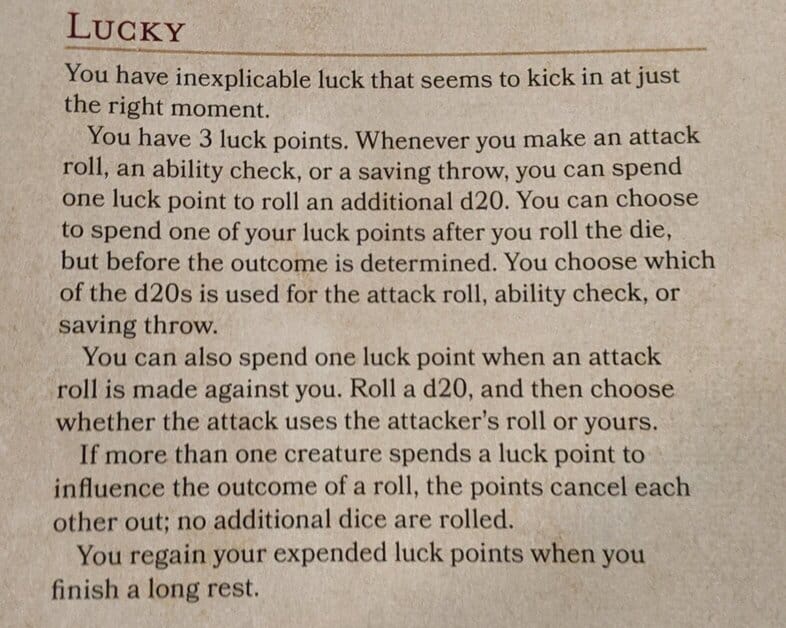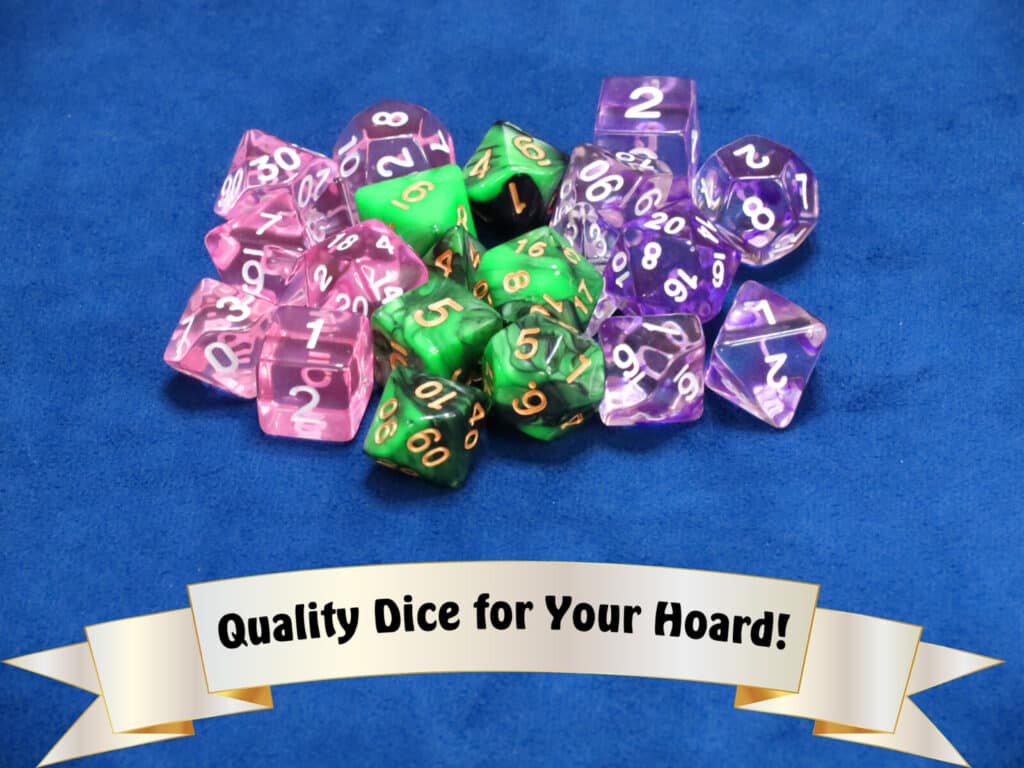Lucky is easily the most versatile feat in 5th Edition Dungeons & Dragons, as it is powerful for every single class and build. This feat is versatile, affects attacks, saves, and checks, and can even be used to undo an enemy critical that hits your own character. In other words it is a jack-of-all-trades potential master of all that is powerful from Level 1 to Level 20, works with every single class, and there’s a reason it’s banned more than any other 5E feat by GMs.
Lucky is one of the strongest, if not the overall strongest, feat in all of 5th Edition D&D. The lucky feat in 5E is good for all classes, all races, and all builds. It should always be on the shortlist of every player looking to pickup a feat in games where the GM hasn’t banned it.
How is lucky overpowered? How can one feat be so good for any class, and how can a GM deal with a party who all have this feat? We have the answers to all this and more just ahead!

Breaking Down the Lucky Feat
The 5E Lucky Feat is one of my favorites as a player, and one of my least favorite as DM. It doesn’t take long to see why, as you can read below:
Directly from the Player’s Handbook:
You have inexplicable luck that seems to kick in at just the right moment.
You have 3 luck points. Whenever you make an attack roll, an ability check, or a saving throw, you can spend one luck point to roll an additional d20. You can choose to spend one of your luck points after you roll the die, but before the outcome is determined. You choose which of the d20s is used for the attack roll, ability check, or saving throw.
You can also spend one luck point when an attack roll is made against you. Roll a d20, and then choose whether the attack uses the attacker’s roll or yours.
If more than one creature spends a luck point to influence the outcome of a roll, the points cancel each other out; no additional dice are rolled.
You regain expended luck points when you finish a long rest.
Player’s Handbook, p. 167
So it’s not too hard to see why these luck points are so powerful. The fact they come back with a long rest encourages liberal use of them, as well. That built-in mechanic helps make sure that a player gets the most out of their feat choice.
Related Article: Looking for the DnD One update? Check out our complete DnD One Lucky Feat Guide!
Benefit #1: Use a luck point to re-roll an attack roll, you can use either die number.
The wording is that you must use the re-roll before you know whether you hit or not, but if you are down in the order or have gone a round, you probably know the enemy’s AC. Or if you rolled terribly, you know for a fact you missed and using a luck point can give you that extra opportunity to turn a miss into a hit.
Turning a miss into a hit is obvious a major boost in damage done as 0 is, well zero. Turning a miss into a hit with a better roll might be the extra little bit that your party needs to get through a really tough fight. This is especially powerful if a high level rogue somehow biffs advantage on the sneak attack. Add one more die, see if you can get that incredible hit in.
Benefit #2: Use a luck point to re-roll an ability check.
Does something in the room not sit right? Are you desperately trying to track a kidnapped member of your own party? That glowing idol belching black magical darkness give you the heebie-jeebies and you rolled 2 on your Arcana check?
Sounds like the perfect time for a luck roll, don’t you think?
This can even be more drastic when an athletics check or acrobatics check gets botched in a place where it might go from check to “save to avoid death” a phrase that has popped up more than once at my table when things have gone terribly sideways. Which brings us straight to the next benefit of the lucky feat.
Benefit #3: Use a luck point to re-roll saving throw.
It’s never a good thing when you need to bring out a saving throw. Sometimes failing a saving throw can be catastrophic. Even fatal for your character. So being able to add a d20 to get advantage on a saving throw you know the first die failed is a major boost. Potentially a life-saving one for your character.
Since a luck point can be used for an ability check or a saving throw,
Benefit #4: Use a luck point to re-roll an enemy’s attack roll
My favorite use of this is making sure that boss actually didn’t crit attack against me. My second favorite is trying to get out of a potential death blow when the DM’s dice are on fire.
This is an incredibly powerful use of a luck point. And considering how much damage the average DnD party puts out, keeping yourself alive for another round or two rounds is often more than enough to see all but the toughest of fights through until the very end.

Bonus Benefit: Meshes with Everything
This goes beyond the conventional feat breakdown, but it is definitely something we should talk about with this feat. Lucky can make other feats even more effective. Have that bonus from alert but still biff the roll? Throw another d20 and let that bonus do its work. Have observant but you just didn’t notice something? Re-roll and have it catch your eye at the last moment.
There are so many times when the benefit or bonus to another feat or to a plan fails but one more chance with lucky was just what was needed. Now if the roll is botched then the dice gods have spoken and move on. But many more times the lucky feat is going to be fate-changing when it comes to the campaign.

5E Classes That Should Take the Lucky Feat
Lucky is a feat that doesn’t break down by class the way that many others do. However, every single player should at least consider picking up this feat. While there are specialty feats that will come first with certain classes and builds (see sharpshooter for the ranger, or polearm master + sentinel for a cleric who loves plant growth and spirit guardians).
However, there is no feat that is as versatile and widely powerful as the lucky feat. It can potentially affect so many rolls, so many saves, so many attacks, and even deflect critical attacks against you. That’s a lot of power in a small package – especially if you’re in a campaign like most where there’s only one battle on average per session.
That means potentially you can use all these extra rolls in battle, and only on rolls that don’t already work. That’s extremely powerful and that situation or setup even further builds up the power of this feat on itself.
There’s no class or build that shouldn’t consider the lucky feat in 5E. I’d argue every single class that has an ability score increase at some point they don’t need should pick up this feat.
5th Ed Classes that should always take the Lucky Feat:
- Not class specific, but every class and every single build should strongly consider this feat as it is one of the strongest in the game. Especially if you rolled for stats and don’t need all your ability scores. In that case this should be a must.
5E Classes That Should Consider Taking the Lucky Feat
All of them. Seriously. If your character needs a specialty feat to maximize what they do like Sharpshooter, Crossbow Expert, Sentinel, Spell Sniper, then by all means grab those first. But then the moment the critical ability scores are maxed out and those specialty feats are taken, then the lucky feat should be next.
For classes or builds that don’t have a clear “must have as soon as possible” specialty, then lucky should be the first feat that you pick up. Even if you have Phil-level luck with dice rolling, at some point this feat will come into play and it will turn some failures into successes.
5th Ed Classes that should consider taking the Lucky Feat:
- All of them.
5E Classes That Should NEVER Take the Lucky Feat
There are no classes or builds in 5E Dungeons & Dragons that would not benefit from the Lucky Feat.
5th Ed classes that should never take the Lucky Feat:
- None of them – this feat is useful for every single class and build.
Final Feat Grade for 5E Lucky
Lucky Feat Grade: A+
Is the 5E Lucky Feat Worth It?
Without question lucky is one of the most powerful and versatile feats in 5E DnD and should be on the shortlist of feats every player wants to take. This feat can give advantage to an attack roll (after you roll the initial attack), re-roll an enemy attack on you (very handy for a crit), re-roll an ability check that went bad, or re-roll a save that you probably failed.
Each one of those uses individually is extremely powerful by itself. Having 3 luck points that can be used for any of those re-rolls, get refreshed during a long rest, and give potential boosts to ability checks, saving throws, PC attacks, and dodging NPC attacks is just incredible. A good story-telling DM will be able to use a situation changed by luck to paint a vivid picture of what’s going on, creating an even more immersive campaign setting.
This is one of the absolute strongest feats in 5E D&D and there’s a reason that it gets one of the very few A grades of any feats we review. It’s just that strong.
5E Lucky Feat FAQ
Is the lucky feat broken?
The 5E lucky feat is not broken, but good arguments can be made that it is over-powered to the point of being close. The versatility of the feat and ability to cancel out crits or turn fails into passes potentially three times per long rest is incredibly powerful.
How does the lucky feat work with advantage/disadvantage?
The lucky feat clearly states rolling another die. This means one d20, as stated. So if the roll had disadvantage, the luck roll is still just one die. If the roll had advantage, it’s still just one d20 for the luck roll. Extra dice aren’t added when using this feat.
Can you use the lucky feat more than once on the same roll?
The lucky feat states that “an additional d20” can be rolled. While in theory it could be argued that this still leaves room for more than one, the phrasing and tense in the rest of the feat indicate that lucky is expected to be used once and only once per roll. A DM might home rule this in another direction, but by the book assume lucky can’t be used more than once on the same roll.
Keep in mind that feats are an optional ruleset despite being widely used. So if a DM chooses not to use them, or chooses to not allow certain ones, that is 100% their perogative.
However if Lucky is in play in your next 5th Ed campaign…you would need to be pretty hard pressed not to pick it.
Other DnD Articles You Might Enjoy
- What Is Passive Perception?
- Dungeon Delver 5E Feat Guide
- 5E Keen Mind Feat
- 5E Skilled Feat
- 5E Defensive Duelist Feat Guide

Proud to embrace the locally created moniker of “Corrupt Overlord” from one of the all time great Lords of Waterdeep runs, Shane is one member of the Assorted Meeples crew and will be hard at work creating awesome content for the website. He is a long-time player of board games, one time semi-professional poker player, and tends to run to the quirky or RPG side of things when it comes to playing video games. He loves tabletop roleplaying systems like Dungeons & Dragons, Pathfinder, Werewolf, Fate, and others, and not only has been a player but has run games as DM for years. You can find his other work in publications like Level Skip or Hobby Lark.

